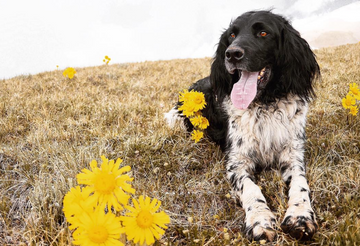We think everything about antlers is fascinating. Their unique colors, shapes, and sizes make them a one-of-a-kind treasure. Additionally, the antler cycle is a true wonder of nature that repeats yearly in antlered animals, making RidgeRunner's antler chews for dogs a truly natural and renewable resource. Have you ever wondered, "when do deer shed their antlers?" We've put together the following guide to help explain this natural phenomenon.
All antlered animals go through this amazing process each year, growing a new set of antlers in the late spring into summer months and then shedding them again the following winter after the mating season. The shed antlers are a coveted treasure sought after by many individuals throughout the country.
Here are a few interesting tidbits about this annual process...
Growth and Timeline of Shedding by Species
ELK typically shed their antlers from late February through early May depending on which part of the county they live in. Elk that live in the warmer climates of Arizona, New Mexico, and Utah tend to shed earlier than elk living in the colder Northern climates of Montana, Wyoming, and Colorado. During the antler growth period, elk antlers can grow between half an inch to one inch per day.
Shop Whole Elk Antler and Split Elk Antler chews for dogs.
DEER generally shed their antlers earlier than elk, from January through March. The exact timing depends on the species and local conditions. Whitetail deer will often shed earlier in the season, while mule deer will shed later in the winter and early spring. During the antler growth period, deer antlers can grow a quarter to a half inch daily.
Shop Deer Antler chews for dogs.
MOOSE tend to shed their antlers the earliest, sometimes as early as December in Alaska and other Northern climates. During the antler growth period, moose antlers can grow 1 inch or more per day. A large moose antler can weigh as much as forty pounds. Imagine carrying up to eighty pounds on your head for half the year! Although we love all antlers, we have a special fondness for moose antlers due to their size, coloration, and uniqueness.
Shop Moose Antler chews for dogs.
What are Antlers?
Antlers are bony structures that grow from the skulls of male elk, deer, moose, and other antlered animals. Unlike horns, which are permanent and grow throughout an animal's life (such as those of sheep, goats, or bison), antlers shed and are regrown annually. They are typically used in competition with other males during the breeding season (also known as the rut) for access to mates.
- Purpose: The primary purpose of antlers is to compete during mating season. Males use their antlers to fight for dominance and access to mates. However, some species, like elk, also use them for display to attract females.
- Regeneration: Each year, the antlers are completely regrown from scratch, making them one of the fastest-growing tissues in the animal kingdom. Some antlers can grow as much as an inch per day!
-
Size Matters: Bigger isn't always better, but in the animal world, it often is. Larger antlers are a sign of health and strength.This means that animals with big antlers tend to have an advantage in mating. However, growing huge antlers takes a lot of energy, so you usually see them in older, healthier males.

Antler Growth and Shedding Cycle
The antler-shedding process is a remarkable part of the elk, deer, and moose life cycle. While all three species experience similar biological triggers for antler shedding, the timing of when it occurs can vary considerably. Factors such as geographic location, health, and age of the individual all contribute to the exact shedding dates. This cyclical process not only plays a role in reproductive strategies but also provides a fascinating glimpse into the seasonal rhythms of these magnificent animals. Whether in the snowy forests of the Rockies or the vast boreal forests of the North, antler shedding is a key event in the lives of these iconic creatures.
Once the breeding season ends and winter approaches, the antlers are no longer needed, and the animal's hormone levels change. This hormonal shift signals the shedding process, usually between late winter and early spring.
The shedding itself is a bit of a mystery—no one knows exactly why or how it happens, but it's generally believed that it's linked to a decline in testosterone levels. The process is natural, and the antlers don't just fall off randomly; rather, they're shed cleanly, often one at a time. Sometimes, shed hunters can find the antlers lying on the ground, a perfect souvenir for nature lovers and hunters alike.
Interestingly, animals like elk, deer, and moose don't feel any pain when their antlers fall off. The antler base has a layer of tissue that weakens as the animal's hormones change, causing the antlers to detach naturally.

The Seasonal Cycle
- Spring/Summer: Antlers begin to grow after the winter months once the previous ones have dropped. They are covered in a velvet-like skin that supplies blood and nutrients to the growing antlers. Depending on the species, antlers can grow from a quarter inch to a full inch each day.
- Late Summer/Fall: By the time the breeding season arrives, the antlers are fully grown, and the velvet covering them has been rubbed off on trees and brush where the animals live. The antlers start bone white and gradually darken as the animal rubs them on the dark bark of trees. Antlers range in color from a light creamy brown to a dark chocolate color, depending on the environment each animal lives in.
- Winter/Spring: After the rut is over, hormonal changes in males trigger the shedding of antlers, and the cycle begins again.
Here at RidgeRunner Antlers, we are very particular (fanatical, some would say!)about the quality of the antlers we procure from our network of shed collectors. We only purchase antlers that shed during the most recent shed cycle, so your pup is getting the freshest antler chews available. All of our antlers come from free-roaming elk, deer, and moose right here in the United States. The timing of the shed cycle for each species does impact the seasonal availability of each type of antler, so there may be periods when we are out of one type or another.



